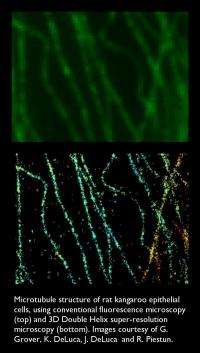This shows microtubule structure of rat kangaroo epithelial cells with conventional fluorescence microscopy, top, and 3-D Double Helix super-resolution microscopy. Credit: G. Grover, K. DeLuca, J. DeLuca and R. Piestun
Double Helix LLC of Boulder and the University of Colorado have completed an exclusive option agreement to allow Double Helix to develop a novel technique for 3D super-resolution imaging.
The technology was developed by CU-Boulder Professor Rafael Piestun of the electrical and computer engineering department. Super-resolution -- techniques to enhance the resolution of an imaging system beyond the limitations set by the diffraction of light -- is key to the development of next-generation microscopes and other optical instruments. The Double Helix optical technology combines 3D optics and a unique signal post-processing technique used for quality improvement in image processing.
The optical technology offers a major opportunity to provide multifunctional 3D super-resolution imaging capability to thousands of cellular, molecular biology and biophysics laboratories in the United States and around the world. The Double Helix technology platform is applicable to a variety of scientific, industrial and consumer applications, including microscopy, metrology and computational digital photography, said Piestun.
Piestun also is the director of Computational Optical Sensing and Imaging, a National Science Foundation-funded program for education and research training.
"We are looking forward to bringing this leading-edge technology to the market, initially in microscopy and later to more markets including metrology and digital optics, a stronghold of the Boulder entrepreneurial community," said Double Helix founding partner Leslie Kimerling.
"We are excited to see this company launch with our broad fundamental patents," said Ted Weverka, a licensing manager at the CU Technology Transfer Office. "The cost savings and superior technology will give Double Helix a strong lead."
Provided by University of Colorado at Boulder



















